It turns out that the Smith chart is still the basic tool for determining the impedance of a transmission line. When dealing with the practical application of the RF system, there are always some very difficult tasks, and matching one of the different impedances of the cascading circuits is one of them. In general, the circuits that need to be matched include the match between the antenna and the low noise amplifier (LNA), the match between the power amplifier output (RFOUT) and the antenna, and the match between the LNA/VCO output and the mixer input. The purpose of matching is to ensure that the signal or energy is effectively transferred from the "signal source" to the "load". At the high frequency end, parasitic components (such as inductance on the wire, capacitance between the layers, and resistance of the conductor) have a significant, unpredictable effect on the matching network. When the frequency is above tens of megahertz, the theoretical calculations and simulations are far from satisfactory. In order to get the appropriate final results, the RF test in the laboratory must be considered and properly tuned. The calculated value is used to determine the type of structure of the circuit and the corresponding target component value. There are many ways to match impedance, including
Computer Simulation: Because this type of software is designed for different functions and not just for impedance matching, it is more complicated to use. Designers must be familiar with entering large amounts of data in the correct format. Designers also need the skills to find useful data from a large number of output results. In addition, circuit emulation software cannot be pre-installed on a computer unless the computer is specifically designed for this purpose.
Manual calculation: This is an extremely cumbersome method because it requires a longer ("several kilometers") calculation formula and the processed data is mostly complex.
Experience: This method can only be used by people who have worked in the RF field for many years. In short, it is only suitable for experienced experts.
Smith Chart: This article will focus on the content.

The chart was invented in 1939 by Phillip Smith, who worked at RCA in the United States. Smith once said, "When I can use the slide rule, I am interested in graphically expressing the mathematical relationship." The basics of the Smith chart are the following formulas.  The Γ in the middle represents the reflection coefficient of the line, that is, S11 in the S-parameter (S-parameter), and ZL is the normalized load value, that is, ZL / Z0. Among them, ZL is the load value of the line itself, and Z0 is the characteristic impedance (intrinsic impedance) value of the transmission line, usually 50Ω is used. To put it simply: just like mathematics, look up and know the value of the reflection coefficient. 2. Why? We don't know now, how did Mr. Smith think of the inspiration for the "Smith Chart" representation? Many students read Smith's original picture, remembering hardbacks, and not asking for it. In fact, there is no attempt to figure out the original intention of Mr. Smith. I personally speculate: Is it inspired by Riemann's geometry to give a plane coordinate system to the "bend". I am expressing the process of this "bending", you understand, the meaning of this figure. (The coordinate system can bend, people try not to "bend"; if it has been bent, I express blessing) Now, I will show you the bend. The world map is actually a process of using a plane to represent a sphere. This process is a "straight".
The Γ in the middle represents the reflection coefficient of the line, that is, S11 in the S-parameter (S-parameter), and ZL is the normalized load value, that is, ZL / Z0. Among them, ZL is the load value of the line itself, and Z0 is the characteristic impedance (intrinsic impedance) value of the transmission line, usually 50Ω is used. To put it simply: just like mathematics, look up and know the value of the reflection coefficient. 2. Why? We don't know now, how did Mr. Smith think of the inspiration for the "Smith Chart" representation? Many students read Smith's original picture, remembering hardbacks, and not asking for it. In fact, there is no attempt to figure out the original intention of Mr. Smith. I personally speculate: Is it inspired by Riemann's geometry to give a plane coordinate system to the "bend". I am expressing the process of this "bending", you understand, the meaning of this figure. (The coordinate system can bend, people try not to "bend"; if it has been bent, I express blessing) Now, I will show you the bend. The world map is actually a process of using a plane to represent a sphere. This process is a "straight".

The original image of Smith, ingenious, is to use a circle to represent an infinite plane. 2.1. First, let us first understand the plane of "infinity." First of all, let's review the impedance of the ideal resistor, capacitor, and inductor. In circuits with resistors, inductors, and capacitors, the blocking effect on the current in the circuit is called impedance. The impedance is usually represented by Z. It is a complex number. It is actually called a resistor. It is called a reactance. The blocking effect of the capacitor on the alternating current in the circuit is called capacitive reactance. The inductance is a hindrance to the alternating current in the circuit. The resistance of capacitors and inductors to alternating current in the circuit is collectively referred to as reactance. The unit of impedance is ohms. R, resistance: In the same circuit, the current through a conductor is proportional to the voltage across the conductor and inversely proportional to the resistance of the conductor. This is Ohm's law. Standard style:  . (The ideal resistance is a real number and does not involve the concept of a complex number). If we introduce the concept of complex numbers in mathematics, we can express the resistance, inductance, and capacitance in the same form of complex impedance. Both: the resistance is still the real number R (the real part of the complex impedance), and the capacitance and inductance are represented by imaginary numbers, respectively:
. (The ideal resistance is a real number and does not involve the concept of a complex number). If we introduce the concept of complex numbers in mathematics, we can express the resistance, inductance, and capacitance in the same form of complex impedance. Both: the resistance is still the real number R (the real part of the complex impedance), and the capacitance and inductance are represented by imaginary numbers, respectively:

Z= R+i( ωL–1/(ωC)) Description: The load is the three types of complex of the resistance, inductance and capacitance of the capacitor. After compounding, it is called “impedanceâ€. It is written as a mathematical formula: impedance Z = R + i (ωL - 1 / (ωC)). Where R is the resistance, ωL is the inductive reactance, and 1/(ωC) is the capacitive reactance. (1) If (ωL–1/ωC) > 0, it is called “inductive loadâ€; (2) Conversely, if (ωL–1/ωC) < 0 is called “capacitive loadâ€. Let's take a closer look at the impedance equation, which is no longer a real number. It becomes a complex number because of the presence of capacitors and inductors.
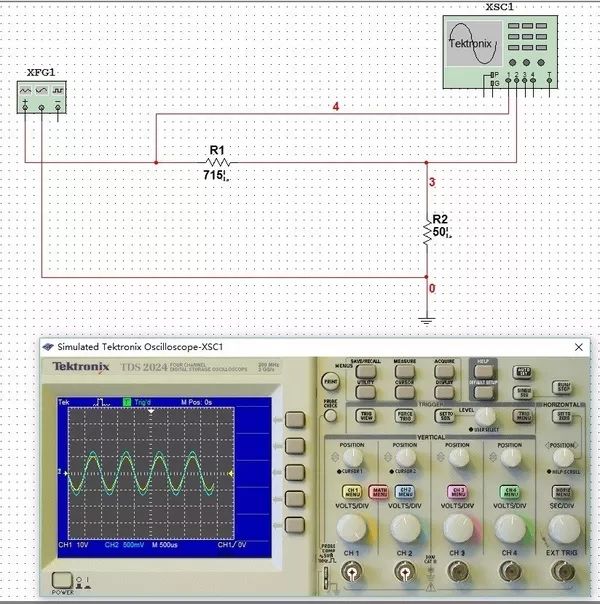
If there is only a resistor in the circuit, it only affects the amplitude change.

From the above figure, we know that the amplitude of the sine wave has changed, and at the same time, the phase has also changed, and the frequency characteristics also change. Therefore, in the process of calculation, we need to consider the real part, but also need to consider the imaginary part. We can represent any complex number in a complex plane with the real part as the x-axis and the imaginary part as the y-axis. Our impedance, no matter how many resistors, capacitors, inductors are connected in series, in parallel, can be represented in a complex plane.

In the RLC series circuit, the AC supply voltage U = 220 V, frequency f = 50 Hz, R = 30 Ω, L = 445 mH, C = 32 mF.
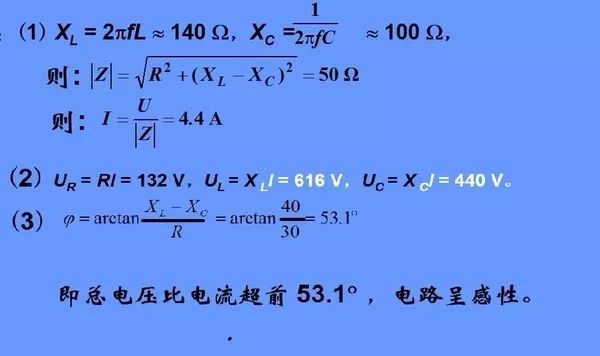

In the above figure, we see the superposition of several vectors, the final impedance in the complex plane, falling in the blue dot position. Therefore, the calculation result of any one impedance can be placed at the corresponding position of this complex plane. The various impedances make up this infinite plane. 2.2. When the reflection formula signal propagates forward along the transmission line, a transient impedance is felt every moment. This impedance may be the transmission line itself, or it may be midway or other components at the end. For a signal, it doesn't distinguish exactly what it is, and the signal only senses the impedance. If the impedance felt by the signal is constant, then it will propagate forward normally, as long as the perceived impedance changes, no matter what it is caused (may be resistance, capacitance, inductance, via, PCB corner encountered in the middle) , connector), the signal will be reflected.

The tide of the Qiantang River is that the width of the channel causes a reflection, which is not consistent with the impedance in the circuit, resulting in signal reflection, which can be analogous. The energy of the reflection gathers together, causing an overshoot. Maybe this metaphor is not appropriate, but it is quite image.

So how much is reflected back to the starting point of the transmission line? An important measure of the amount of signal reflection is the reflection coefficient, which is the ratio of the reflected voltage to the original transmitted signal voltage. The reflection coefficient is defined as:
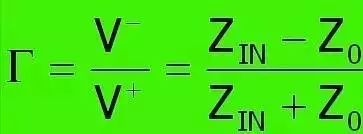
Where: Z0 is the impedance before the change, and ZIN is the impedance after the change. Assuming that the characteristic impedance of the PCB line is 50 ohms, a 100 ohm chip resistor is encountered during transmission. The effect of the parasitic capacitance inductance is not considered for the time being. The resistance is regarded as the ideal pure resistance, and the reflection coefficient is:  One third of the signal is reflected back to the source. If the voltage of the transmitted signal is 3.3V, the reflected voltage is 1.1V. The reflection of a purely resistive load is the basis for studying the reflection phenomenon. The change of the resistive load is nothing more than the following four cases: the finite value of the impedance increases, the finite value decreases, the open circuit (the impedance becomes infinite), the short circuit (the impedance suddenly becomes 0) ).
One third of the signal is reflected back to the source. If the voltage of the transmitted signal is 3.3V, the reflected voltage is 1.1V. The reflection of a purely resistive load is the basis for studying the reflection phenomenon. The change of the resistive load is nothing more than the following four cases: the finite value of the impedance increases, the finite value decreases, the open circuit (the impedance becomes infinite), the short circuit (the impedance suddenly becomes 0) ).

The initial voltage is the source voltage Vs (2V) divided by Zs (25 ohms) and transmission line impedance (50 ohms). The subsequent reflectivity of Vinitial=1.33V is calculated according to the reflection coefficient formula.

The reflectivity at the source is calculated from the source impedance (25 ohms) and the transmission line impedance (50 ohms) according to the reflection coefficient formula to -0.33; the terminal reflectivity is based on the termination impedance (infinity) and the transmission line impedance (50 ohms). The reflection coefficient formula is calculated as 1; we obtain this waveform by superimposing on the initial pulse waveform according to the amplitude and delay of each reflection, which is why the impedance mismatch causes poor signal integrity.
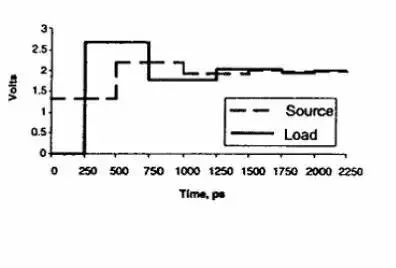
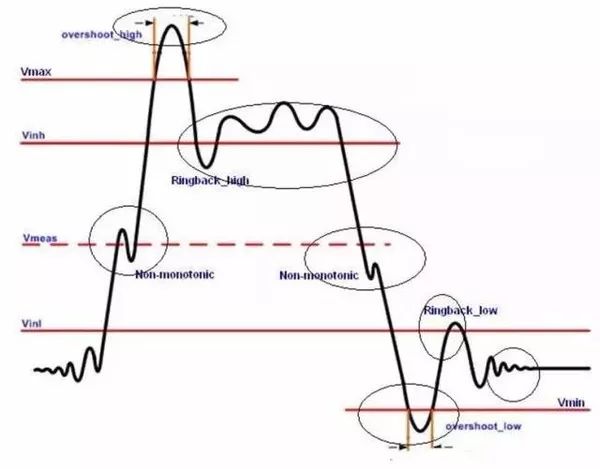
Then we make an important assumption! In order to reduce the number of unknown parameters, it is possible to cure a parameter that often occurs and is often used in applications. Here Z0 (characteristic impedance) is usually a constant and is a real number, which is a commonly used normalized standard value such as 50 Ω, 75 Ω, 100 Ω, and 600 Ω. Assuming Z0 is certain, it is 50 ohms. (Why is it 50 ohms, it is not listed here; of course, other assumptions can be made to make it easier to understand. We will definitely decide to die 50Ω). Then, according to the reflection formula, we get an important conclusion:

We portray the correspondence to the "complex plane" we just said. So we can define the normalized load impedance: 

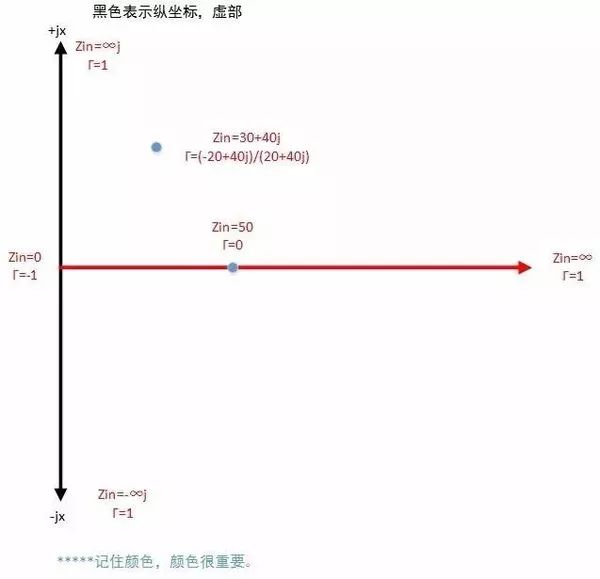
Ok, we are in the complex plane, forget Zin, just remember z (lowercase) and the reflection coefficient "Γ". Preparations are all done, below we are ready to "bend" 2.3 掰 bend

In the complex plane, there are three points, and the reflection coefficient is 1, which is the infinity of the abscissa and the positive and negative infinity of the ordinate. One day in history, Mr. Smith, if you have the help of God, bend the black line and pinch the points marked in the three red circles in the above picture. Bent, bent

Round, round.

Perfect circle:
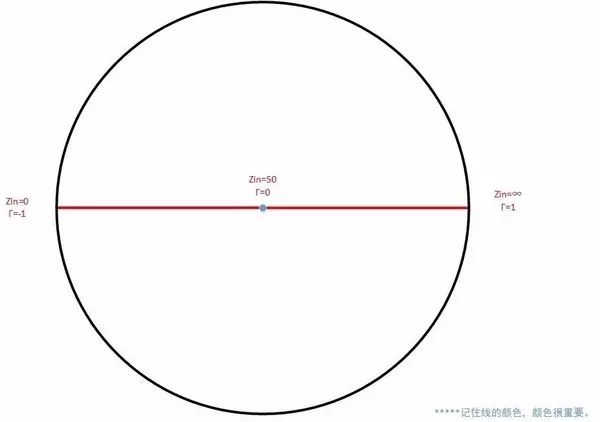
Although the infinity plane becomes a circle, the red line is still a red line, and the black line is still a black line. At the same time, we added three lines to the original complex plane, which also curved as the plane closed.
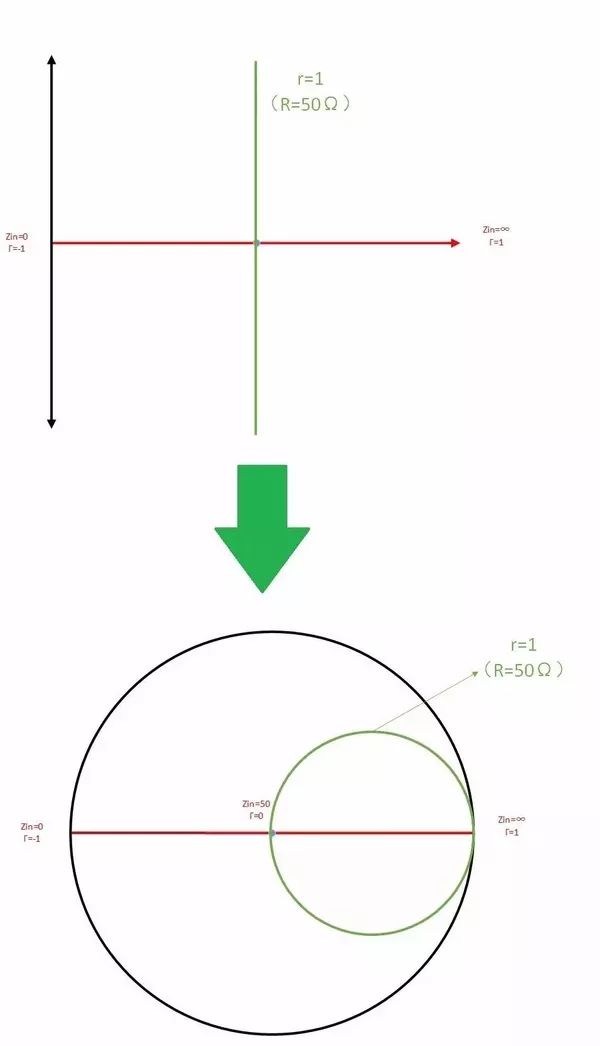
The impedance of the black line has a characteristic: the real part is 0; (resistance is 0) the impedance of the red line has a characteristic: the imaginary part is 0; (inductance, capacitance is 0) the impedance on the green line There is a characteristic: the real part is 1; (resistance is 50 ohms) The impedance of the purple line has a characteristic: the imaginary part is -1; the impedance of the blue line has a characteristic: the imaginary part is 1;

The impedance characteristics of the line, we are moving from the complex plane to the original image of Smith, so the characteristics follow the color and the characteristics are unchanged.
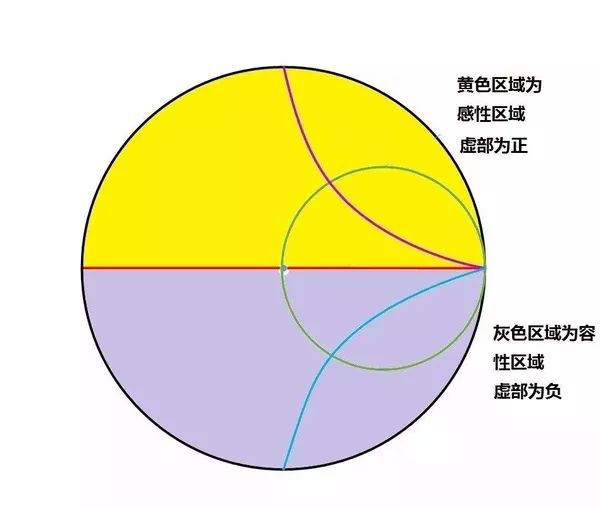
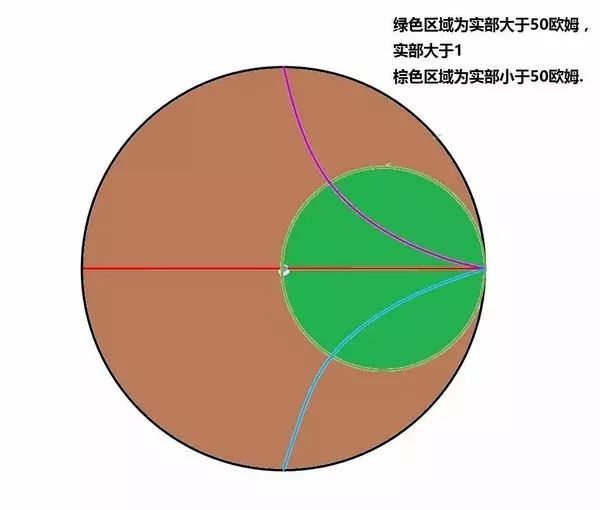
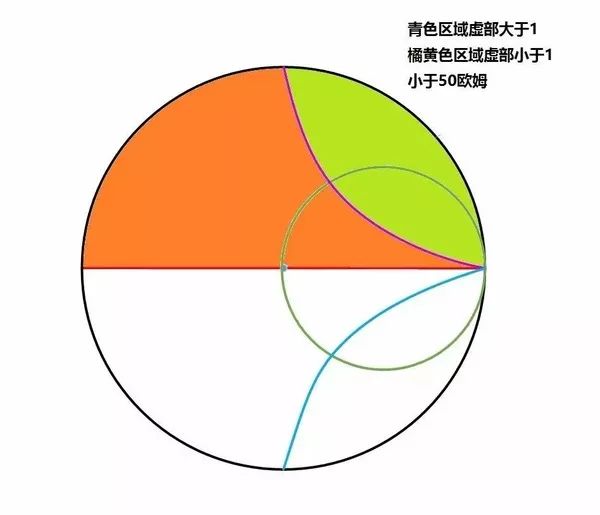
The lower semicircle is the same division as the working circle.

Because the Smith chart is a graph-based solution, the accuracy of the results is directly dependent on the accuracy of the graph. The following is an example of an RF application represented by a Smith chart: Example: The known characteristic impedance is 50Ω and the load impedance is as follows:
| Z1= 100 + j50Ω | Z2= 75 - j100Ω | Z3= j200Ω | Z4= 150Ω |
| Z5= ∞ (an open circuit) | Z6= 0 (a short circuit) | Z7= 50Ω | Z8= 184 - j900Ω |
Normalize the above values ​​and mark them in the circle chart (see Figure 5):
| Z1= 2 + j | Z2= 1.5 - j2 | Z3= j4 | Z4= 3 |
| Z5= 8 | Z6= 0 | Z7= 1 | Z8= 3.68 - j18 |
We can't see the picture above. If it is "series", we can first determine the real part on the clear Smith original image (the red line is found, the horizontal coordinate of the original complex plane), and then according to the imaginary part of the imaginary part, slide along the arc to find our corresponding Impedance. (Ignore the green line in the figure below)

The reflection coefficient Γ can now be solved directly from the circle diagram. We can either directly read the value of the reflection coefficient by Cartesian coordinates or read the value of the reflection coefficient by polar coordinates. The rectangular coordinates plot the impedance point (the intersection of the equal impedance circle and the equal reactance circle). As long as they are projected on the horizontal and vertical axes of the Cartesian coordinate, the real part Γr and the imaginary part åå°„i of the reflection coefficient are obtained. 6). There may be eight cases in this example. The corresponding reflection coefficient can be directly obtained on the Smith chart shown in Figure 6:
| Γ1= 0.4 + 0.2j | Γ2= 0.51 - 0.4j | Γ3= 0.875 + 0.48j | Γ4= 0.5 |
| Γ5= 1 | Γ6= -1 | Γ7= 0 | Γ8= 0.96 - 0.1j |
Direct reading of the real and imaginary polar coordinates of the reflection coefficient Γ from the XY axis
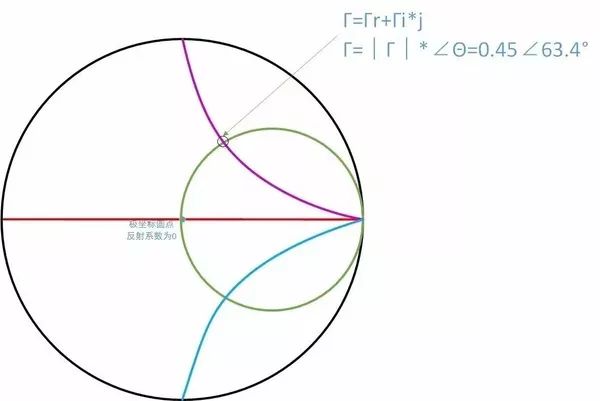
Polar coordinates, what is the use? Very useful, this is actually the purpose of Smith's original picture. 2.4 Red Camp VS Green Camp

We have just noticed that the original picture of Smith, in addition to the red curve, is the red world from the complex plane of the impedance. At the same time, in the figure, there are green curves, which are generated from the admittance complex plane and the bend. The process is the same as the one just after. So what is the use of this green admittance? Parallel circuits, using admittance calculations, we will be very convenient. At the same time, in the original Smith chart, we can use the green curve of the admittance to query, it will be very convenient.
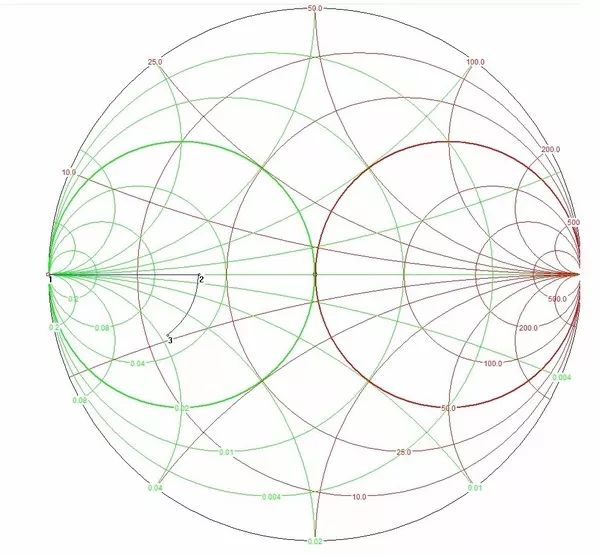

As shown in the figure, a capacitor is connected in parallel, and the corresponding normalized impedance and reflection coefficient can be quickly queried through the green curve. 3. What are you doing? Explain and introduce the long paragraph of the Smith chart, don't forget what we want to do. We actually hope that the circuit reflection coefficient we design is closer to 0. But what kind of circuit is a qualified circuit? The reflection coefficient cannot be ideally zero, so what are our requirements for the reflection coefficient? We want the absolute value of the reflection coefficient to be less than 1/3, that is, the reflection coefficient falls into the blue area of ​​the Smith chart (as shown below).

What is the characteristic of this blue ball? In fact, we have clearly found out through the value of Smith's original image. On the central axis, which is the red line previously mentioned, it is 25 ohms and 100 ohms respectively. That is: Zin is in the area between 1/2 Zo and 2 times Zo.
That is, we target the blue area and think that the reflection coefficient is acceptable.
Mobile phones and earphones have become necessities in our lives. How many people feel restless when they don`t have a mobile phone around. The mobile phone gives us a great sense of security to a certain extent, and its additional earphones also have such a function. . Wear headphones when you don`t want to talk; when you don`t want to listen to others, you wear headphones; when you don`t want to be harassed in an unfamiliar environment, you can play your favorite songs, be happy or sad, and enjoy your little universe most comfortable. There are now a variety of earphones on the market for people to choose from. From the original wired earphones to the current wireless Bluetooth earphones, they are more and more in line with people's requirements, and the sound quality and noise reduction are also constantly improving.
If you want to get a sports headset (sports scene) or a true wireless tws true wireless Bluetooth headset, what you expect from him is that it has the ability to withstand the test of different environments, wear it steadily, and have a long battery life, or it may be out of the street. Appearance, excellent sound quality, stable connection, friends who have certain requirements for sound quality and low requirements for noise reduction. You can take a look our earbuds.
Bluetooth Earphones,True Wireless Earbuds,Waterproof Stereo Earphones In-Ear,Ultra-Light Earbuds
Shenzhen Focras Technology Co.,Ltd , https://www.focrass.com